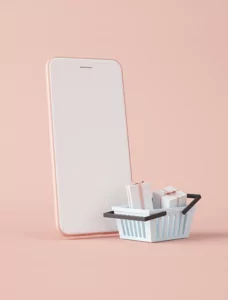
- Red Search
- Resources
- iPhone Mobile Phone Statistics Australia
Apple iPhone Mobile Phone Statistics Australia
-
 Daniel Law
Daniel Law
Amid the tight market competition for smartphone brands in Australia, the iPhone has undoubtedly revolutionised the smartphone landscape. It became the most recognisable brand, captivating the hands of millions who use it for either personal or business operations.
In 2023, the iPhone recorded 234.6 million units sold, outselling the South Korean tech firm’s 226.6 million units sold.
Such an increasing gap in sold units proves that iPhones are now capturing a more diverse global audience, particularly in regions with high loyalty for high-end smartphones. In Australia, for example, iPhones have had a consistent market lead since 2011, with over 50% market share.
As Apple offers highly anticipated new models and features, user-friendly interfaces, and extensive applications, its iPhone products will continuously become the game changer in the smartphone industry.
Let’s dive into the comprehensive statistics contributing to the iPhone’s prevalence in Australia’s digital landscape.
iPhone Market Share in Australia
The iPhone’s remarkable impact on the smartphone industry stems from its continuous innovation. Its state-of-the-art software and hardware, including enhanced security features and AI capabilities, capture each tech-savvy’s interest.
As of January 2024, iPhone holds a significant 60% share of Australia’s operating system market. Such a huge margin compared to its competitors indicates a strong brand loyalty and consumer preference for iPhones among Australians.
Mobile Operating System Market Share Worldwide
Sept 2023 – Sept 2024
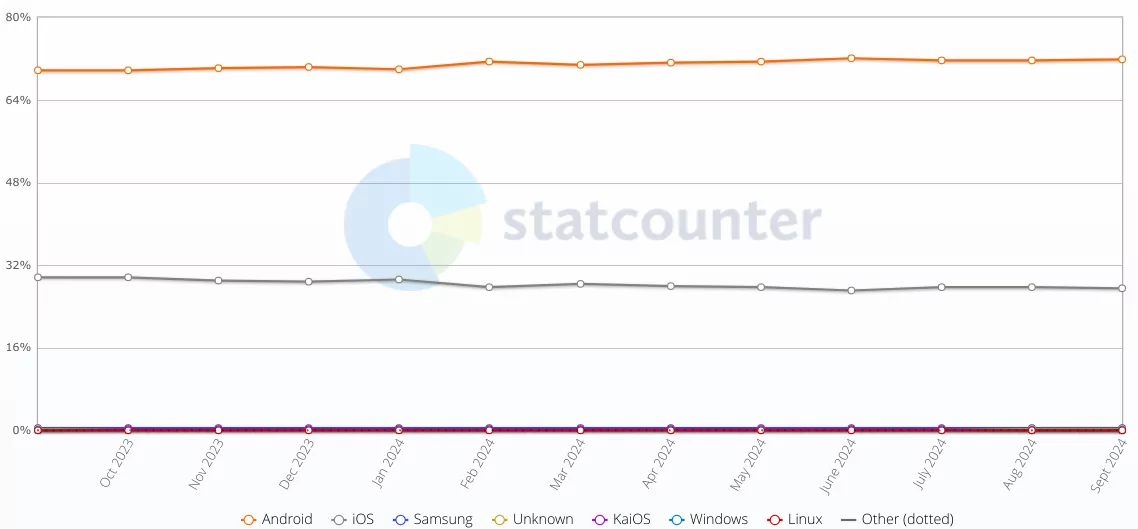
Source: Statcounter Global Stats
However, the IDC Worldwide Quarterly Mobile Phone Tracker has shown a 9.3% decline in smartphone shipments in Australia.
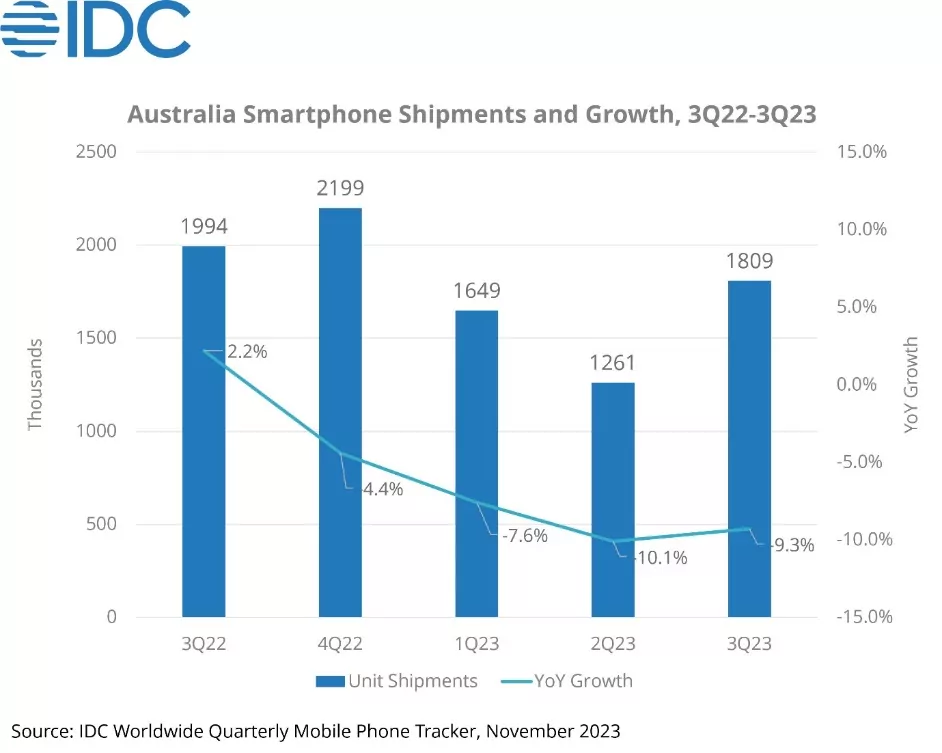
Source: IDC
Despite the slight decline in overall smartphone sales in Australia, the iPhone’s market share has shown resilience as it plunges to release new models and adopt 5G technology.
iPhone Sales Trend
Since its inception in 2007, the iPhone has skyrocketed in popularity, profoundly penetrating the smartphone market globally.
The iPhone remains Apple’s top profit maker, generating $192 billion in 2021. That is a $55 billion increase compared to the $137 billion revenue in 2020.
The Apple App Store’s wide range of applications makes iPhones a formidable choice among smartphone users. With 1.96 million apps available, the app store kept consumer spending up to $34.9 billion in 2023, a 7% increase compared to the previous year.
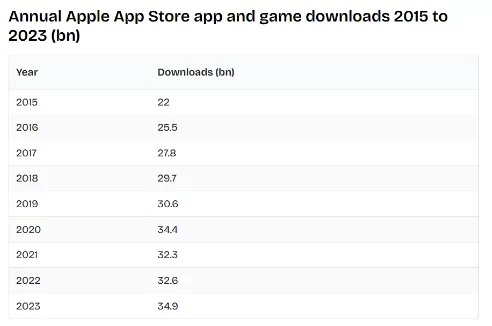
Sources: App Data Report, AppFigures, Sensor Tower
Expectedly, smartphone market penetration could reach 86%, over half dominated by iPhone users. Australia’s consistent growth of iPhone users cemented its status as Apple’s core market.
iPhone User Demographics
Market share held by smartphone operating systems in Australia from 2012 to 2023
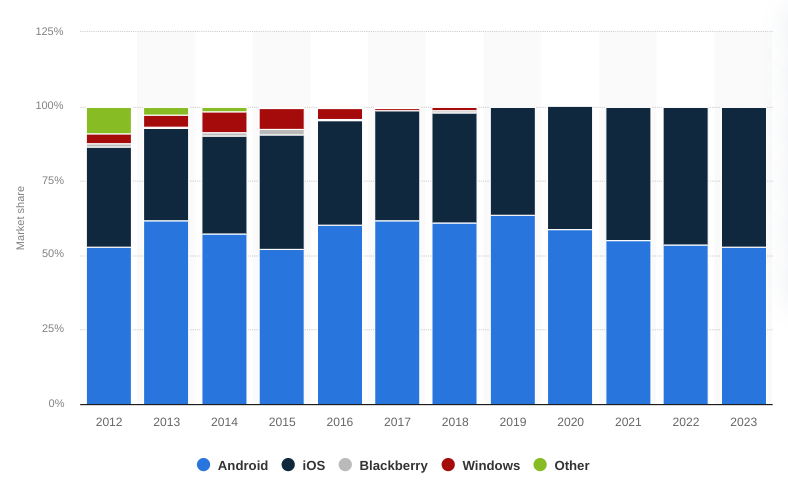
Source: Statista
As of 2024, over 90% of Australians aged 15-65 own a smartphone, with over 81% accessing the internet through their mobile phones.
Comparatively, 31% of iPhone users are female, while 28% are male. Regardless of these values, Android still has a broader appeal globally than iOS.
Here’s the age distribution of iPhone users worldwide:
- 18-24 years old: 20%
- 25-34 years old: 23%
- 35-44 years old: 20%
- 45-54 years old: 16%
- 55+ years old: 21%
Different models of iPhone devices are popular among people aged 18-34, valuing its advanced features and social media capabilities. This age group constitutes over one-third of the Australian population, likely bolstering demand for the product.
A deeper look at user demographics suggests that high-income individuals are likely to own an iPhone due to its premium pricing strategies. At times, iPhone ownership is more common among tech-savvy individuals who prioritise technology in their personal and professional lives.
iPhone Usage Statistics
According to a 2021 survey, the average Australian will spend a total of 17 years using smartphones (145,800 hours over a lifetime!). In 2022, that sobering number has risen to 17.25 years across a lifetime.
Here is the breakdown of smartphone screentime per generation among Australians:
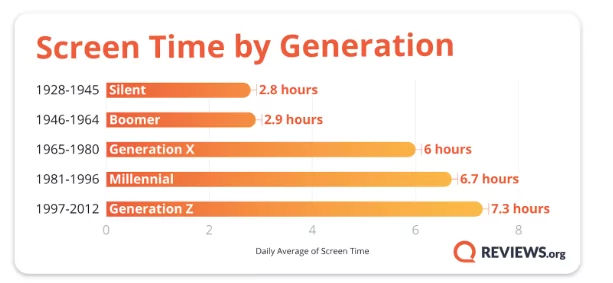
Source: Reviews.org
Below is the top mobile phone usage in Australia in recent years:
- Social Networking Apps: A staggering three-quarters (72%) of Australian adults used social networking apps in 2020, a bit higher than in 2019 (63%).
- Instant Messaging Apps: In 2019, about 96% of smartphone users in Australia used their mobile phones to send messages.
- Entertainment Media Apps: iPhones’ advanced features elevated streaming services, providing top-notch experiences among users.
Although other mobile phone brands have similar usage patterns, iPhone users tend to spend more time on premium applications and services.
As of June 2023, Google was the most downloaded iPhone app with 6.36 million downloads.
List showing the most downloaded apps in the Apple App Store as of June 2023:
- Google: 6.36 million
- CapCut: 6.16 million
- ICOCA: 5.23 million
- ChatGPT: 4.65 million
- TikTok: 4.12 million
- WhatsApp Messenger: 3.91 million
- YouTube: 3.66 million
- Instagram: 3.54 million
- Google Chrome: 2.69 million
- Netflix: 2.36 million
iPhone & 5G Adoption
5G is the latest network technology that offers astonishingly low latency, high capacity, and increased bandwidth. Its massive network capacity can transfer 10 Gbps, a hundred times increase beyond the currently known 4G.
With its next-generation features and capabilities, such network improvements will impact Australian iPhone users’ lives, play, and work.
iPhone Preferences Over Fast Network
iPhone users are particularly inclined to upgrade to models with 5G capabilities. These capabilities enable users to stream higher-quality videos, download movies, and FaceTime in high definition at high speeds.
Preferred iPhone Network Providers
Major providers such as Telstra, Optus, and Vodafone dominate Australia’s telecommunication market. Among these, Telstra’s extensive network coverage and 5G infrastructure make it the most popular choice among Aussie iPhone users.
The advent of 5G technology is an intense race as more users opt for the swiftest mobile internet speed. Telecom company Telstra plans to extend 5G coverage to 95% of Australians by 2026, possibly rolling out 6G networks.
The wide availability of 5G networks benefitted users with faster load times and smoother experiences. Despite that, 5G coverage requires a compatible plan and specific area coverage outside the cities and suburbs.
iPhone High Data Usage Patterns
iPhone users exhibit high data usage patterns driven by streaming, gaming, and social media activities. The shift to 5G is integral to increasing data consumption as users engage with more bandwidth-intensive applications.
Environmental Statistics of iPhones in Australia
With a forecast exceeding 23.3 million Australian internet users by 2025, utilising top-notch mobile phones like iPhones is vital to augment daily productivity.
But that deep integration of smartphones into Aussie’s daily lifestyle equates to skyrocketing demands for mobile phones.
Such insurmountable demands pose pressing environmental issues, such as sustainable resource use, carbon emissions, energy efficiency, and electronics disposal.
Even a juggernaut like Apple is not exempt from environmental challenges in producing millions of iPhone units. On a positive note, the company details its efforts in using recycled materials, reducing carbon emissions, and enhancing energy efficiency in the iPhone.
iPhone Uses Recycled Materials
In Apple’s recent report, almost 22% of its shipped items came from recycled and renewable resources.
Each recent model has different mind-boggling recycling stats.
- iPhone 12: 100% recycled rare earth elements in all magnets
- iPhone 13: 100% certified recycled gold
- iPhone 14: 100% recycled rare earth elements in all magnets
- iPhone 15: 23% recycled or renewable content & 100% recycled cobalt battery
iPhone Reduces Carbon Emissions
According to a similar report, an iPhone 13 emits 64kg of carbon dioxide equivalent (CO2e) in its life cycle. The emission is reduced by 28%, with iPhone 15’s 56kg C02e in its entire life span.
Consequently, the iPhone is dedicated to reducing carbon emissions at every stage of production, and minute adjustments are made to newer models to lower emissions.
iPhone Environment-Friendly Practices
Apple crafted recent iPhone models tailored to benefit the planet sustainably. Here are some measures they take to achieve those goals:
- Responsible Packaging: Zero plastic packaging prompts newer models to opt for fibre-based or recycled, responsibly sourced wood fibres.
- Energy Efficiency: iPhone consumes over 50% less required for battery charger systems
- Smarter Chemistry: iPhones are free of harmful substances such as beryllium, brominated flame retardants, PVC, phthalates, glass arsenic, & mercury.
- Optimal Recovery: iPhone recycles to the highest standards. Old products can be replaced with newer models through Apple Trade-In. This ingenious idea allows the recycling of older, damaged models, maximising material recovery.
Future Growth of iPhones in Australia
The Australian smartphone market’s slight decline suggests economic pressure, leading to cautious consumer spending. While financial turmoil may affect overall market growth, Apple’s strategic positioning and continuous innovation will likely sustain its leading market share.
From 2024 onwards, the Australian smartphone market forecast projected a compound annual growth rate (CAGR) of 0.88%, underscoring revenues expected to reach a whopping AU$3.4 billion.
5G integration and AI-enhanced capabilities are significant drivers of future transition in Australia’s digital landscape. The evolving demand for advanced smartphones presents numerous growth opportunities for iPhones through new model launches.
In A Nutshell
There are over 1.46 billion iPhone users worldwide, with the forecast expected to surpass the 1.56 billion mark in 2025. However, the global smartphone market is dynamically changing, opening endless opportunities for smartphone developments and innovations.
The future growth of iPhones in Australia appears promising, with market share increase catapulted by new models and features, technological advancements, and a shift towards premium devices.
Almost everyone owning an iPhone has become a status symbol for Aussies to adapt to a heavily technology-reliant lifestyle.
Beyond integrating state-of-the-art features, iPhones’ proven innovation, exceptional quality, and sustainability make the product well-positioned to be one of our most reliable, pocket-sized companions.
As a Sydney SEO Agency, we help businesses exponentially grow and scale online. We craft strategies that help various Australian industries elevate businesses’ lasting impression in the digital landscape.
For more on Australian statistics, see our other articles:
Written by






